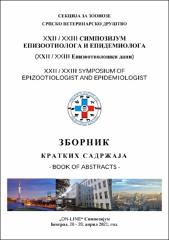Zajedničke osobine ovčije svrabeži i hronične slabosti jelena

View/
Date
2021-04-26Author
Vučićević, Ivana
Đurđević, Biljana
Nešić, Slađan
Aleksić-Kovačević, Sanja
Metadata
Show full item recordAbstract
Transmissible spongiform encephalopathies (TSEs) are fatal protein-misfolding neurodegenerative diseases of humans and different animal species. TSEs affecting animals include scrapie, recognized for over 300 years in sheep and goats; bovine spongiform encephalopathy (BSE), the only animal prion disease known to affect humans; feline spongiform encephalopathy (FSE), transmissible mink encephalopathy (TME) and chronic wasting disease (CWD) that is of considerable concern within cervids. Based on epidemiology and pathogenesis, all these TSEs can be classified into two groups. The first group comprises TSEs that can be transmitted horizontally between animals, have the ability to sustain into the host population and the presence of the agent in the lymph nodes in the early stage of the disease. To this group belong Scrapie and CWD. The second group consists of TSEs of other animal species, which are characterized by the oral route of infection, inability to sustain into host populations and limited involvement of lymph nodes. Scrapie and CWD can be also transmitted indirectly via the environment. Vertical transmission has been reported in sheep and some cervid species. The placenta milk and colostrum of small ruminants and cervids can contain pathologic prion proteins. Bodily secretions of sheep and cervids, such as saliva, blood, urine and feces can be infectious too. Prions were found in the antler velvet of cervids, which humans consume as a nutritional supplement. In the skin of hamsters orally infected with scrapie, prions were also observed. Bearing in mind that Scrapie and CWD occur in different species, it is very interesting that these two diseases have many features in common.
